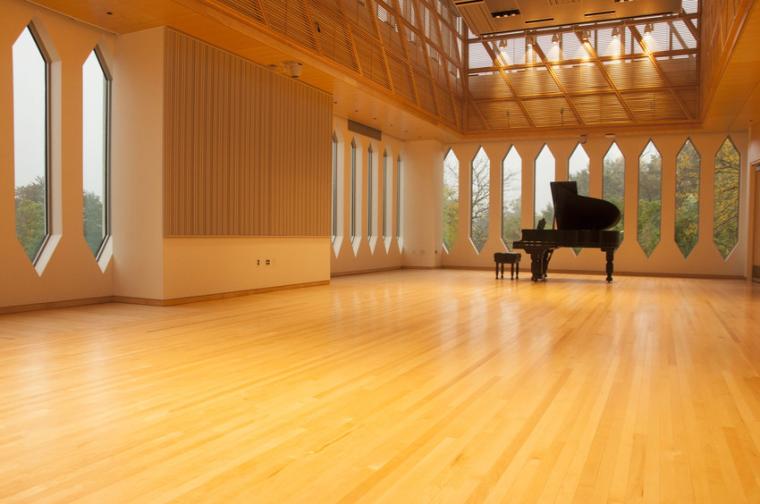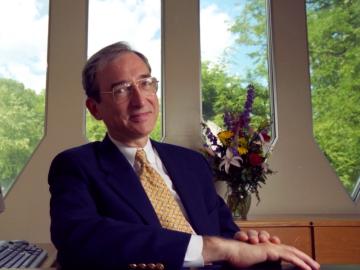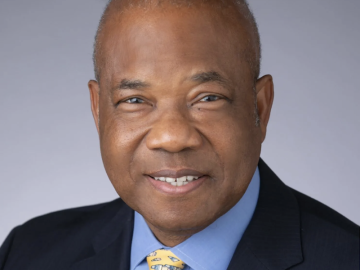Campus News
Stull Hall Earns Acclaim
November 26, 2013
Erich Burnett

The conservatory performance space built atop Bibbins Hall during summer 2013—the David H. Stull Recital Hall—has earned an Honor Award, the highest accolade bestowed by the Cleveland-area chapters of the American Institute of Architects (AIA) and the American Society of Interior Designers (ASID) .
“This project is proof that true beauty results from a clear architectural response to the design problem,” the jury wrote in its remarks. “The intervention of this new recital and performance hall within the current Oberlin Conservatory of Music complex results in a solution that is sensitive to the rhythm and formal language of the existing 1964 building yet provocative in its innovative response to mediating natural light and challenging acoustic requirements. The jury all agreed that this is a beautifully executed project.”
The award was presented to the project architects, Westlake Reed Leskosky, the Cleveland-based firm that also created Oberlin’s Bertram and Judith Kohl Building, at the 2013 AIA Cleveland + ASID Ohio North Design Awards celebration on November 15.

Stull Hall addresses the conservatory’s ever-increasing need for performance space and pays tribute to one of the institution’s most influential former leaders—David H. Stull ’89, dean of the conservatory from 2004 to 2013, under whose leadership the conservatory made immense strides in upgrading its facilities and resources for students.
“David Stull was a great champion of the Oberlin Conservatory and a tireless advocate for its students and faculty,” says Oberlin President Marvin Krislov. “He loved nothing more than attending their performances, so it is wonderful that this hall will bear his name and help inspire future generations of talented Oberlin musicians.”
To Professor of Musicology Steven Plank, Stull Hall represents “a way of making imaginative things possible”—to coax innovative new uses out of familiar settings.
“This is going to give us wonderful breathing room,” says Plank, an Oberlin faculty member since 1980. “In the past several decades, one of the major issues here has been the space crunch. If you look at the course catalog from 1970 and a catalog from now, it will make your head spin at how much more is going on here.”
Envisioned by Stull himself as part of ongoing renovations to Bibbins, the newly created hall repurposes two former classrooms and two teaching studios on the building’s third floor. In order to accommodate the acoustical needs of a true recital space, the ceiling was raised roughly eight feet. Made of structural steel and glass that honors the aesthetic of the original building, Stull Hall’s vaulted ceiling rises above the roofline of Bibbins.
“We wanted to respect the architecture: to be sensitive to the initial design while enabling a new function,” says Nick Bobulsky, Oberlin’s construction manager. Bobulsky’s crews began work on Stull Hall on May 28—one day after Oberlin’s 2013 commencement activities were completed.
Created in 1963, Bibbins Hall was designed by noted architect Minoru Yamasaki, who later mimicked the look of Bibbins in his best-known creation, the former World Trade Center in New York City. Yamasaki also designed Oberlin’s King Building and Rice Hall, situated diagonally opposite Bibbins at the southwest corner of Tappan Square.
Crafted with optimal flexibility in mind, Stull Hall consists of a 1,300-square-foot performance space, which can be configured in several ways and can accommodate roughly 120 guests. Other features include a green room, display cases, and a storage closet designed to hold the hall’s chairs when necessary. The room will offer capability for live streaming and recording of concerts using technology housed in the Kohl Building’s recording studio, Clonick Hall. It also allows students to record their own playing, providing an essential tool and a vital part of their musical development.
“When we discussed the ways we could pay tribute to David, we agreed that it should happen in a way that would be part of the daily flow of life here at the conservatory and that would exemplify his great commitment to teaching,” says Acting Dean of the Conservatory Andrea Kalyn, who succeeded Stull in July. “This space captures the essence of David's visionary leadership over the last decade.”
The new hall is part of a multi-year renovation plan for Bibbins, which began in summer 2012 with a complete makeover of the second floor that resulted in a series of technologically superior classrooms. This summer, framed reproductions of artwork from the Allen Memorial Art Museum were installed throughout the second floor. Additional renovations of the third floor will continue during the summer of 2014.
The name “Stull Hall” was put forth by the conservatory’s faculty council and met with widespread support. In July, Stull assumed the role of president at the San Francisco Conservatory, after 17 years at Oberlin, first as a student in the late 1980s and later as an administrator.
“When word came that David was leaving, one of the first agenda items was how to pay tribute to him,” says Plank, a member of the faculty council. “I think this is very fitting. He left his mark here in many ways, but quite prominently in terms of space.”
Reservations for use of Stull Hall can be made through the conservatory’s concert production office.
Tags:
You may also like…
Chet Arcaba Earns 2024 YB Award for Extraordinary Service
May 6, 2024
Now 45 years into his Oberlin career, director of facilities stewardship garners widespread praise for his tireless dedication to the campus and community.
Remembering Robert Dodson, 11th Dean of Oberlin Conservatory
October 27, 2023
Educator, performer, and administrator helmed numerous major music schools.
Victor Hymes ’79 Named to Audubon Society Board
August 31, 2023
Entrepreneur and financier Victor Hymes, a 1979 graduate of Oberlin College and Conservatory, has been named to the Audubon Society’s national board of directors. A resident of San Francisco,...


